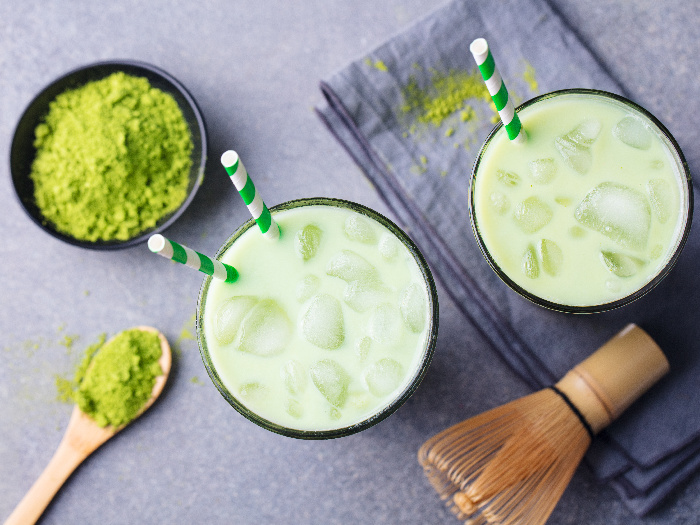In today’s fast-paced world everything becomes popular with the advent of social media. From fashion to food, everyone follows the trend without delay. In the tea world, matcha tea and green tea are immensely popular, making us wonder about the differences between them – and that makes sense. This is because both are rich in appearance, taste, and health benefits. The matcha tea is a must-feature for fitness gurus and influencers alike whereas green tea is a favorite amongst new fitness freaks and celebrities. Moreover, both the teas are rich in nutrients and antioxidants; and not to forget that matcha lattes are really gorgeous to look at! The diverse nutrients present in both teas help provide free radical scavenging activity, and stronger immune defense. But when it comes to matcha vs green tea – there has to be one winner. Let us take a look at them in detail below.
Matcha Vs Green Tea – Who Is The Clear Winner?
Before we arrive at a conclusion, let’s assess the differences between the two on the basis of the manufacturing process, nutritional density, preparation, and pricing.

Matcha green tea iced latte Photo Credit: Shutterstock
Manufacturing Process
The first and foremost difference between green tea and matcha tea lies in the source of the plant. The climate in which the leaves grow and the harvesting procedure gives a distinctive flavor and texture to both the teas.
- Cultivation: Matcha tea and green tea are cultivated differently. Green tea is cultivated under the sun, whereas matcha tea is shade-grown three weeks prior to its harvest.
- Color: Green tea has a dull green color with brownish tones, and matcha tea grows a vibrant green color. The vibrant color comes from the high levels of chlorophyll, a powerful polyphenol.
- Harvest: During harvest season, green tea is cut and sent to a processing plant where it undergoes steam to cease fermentation. The leaves are blow-dried by a whirling machine. Inversely, matcha leaves are harvested by hand-picking the best tea leaves from the plant. The veins and stems are removed, and the leaves are stone-crushed into matcha powder.
Nutritional Density
Matcha tea and green tea are unimaginably popular among health-conscious individuals for the positive effects they have on both physical and mental well-being. However, the shading and sunlight deprivation process of the matcha plant gives it a higher nutritional value as compared to green tea that does not grow in the shade. Given below is the comparative analysis of nutrients for matcha vs green tea:
Tannins
Tannins are naturally occurring micronutrients that come from plants and are found in many wines and teas.
- Matcha – 99 mg
- Green tea – 7 mg
Amino Acids
L-Theanine is an essential amino acid offering the energy shoot-up of caffeine without the caffeine overdose. Amino acids are beneficial for improving memory, learning, and creativity. [1]
- Matcha – 45 mg
- Green tea – 3 mg
Caffeine
One cup of matcha has a higher percentage of caffeine compared to one cup of green tea. Numerically speaking, one cup of matcha provides 34 mg of caffeine, which is the same as one cup of brewed coffee and half the amount of espresso. According to USDA FoodData Central, one cup of green tea amounts to 29.4 mg of caffeine per serving. This measurement differs depending on the time taken to steep the tea. Longer steep time is equal to higher caffeine content. The caffeine content lessens each time the tea is re-steeped. [2]
Preparation
Both the teas can be prepared cold or hot. Matcha tea is whisked into hot water or shaken with a matcha shaker when preparing iced matcha. Alternatively, green tea is prepared best at a mild water temperature of 180 – 185 ℉, with a steep time of about 3 minutes.
Water that is too hot can result in the release of tannins from the leaves, causing both the teas to become astringent.
Pricing
Green tea comes in a variety of blends, prices, and variants. The inexpensive varieties are the ones that are mass-produced giving the big brands a run for their money. But even rare, high-quality green teas will set you back less than $1 per cup. The best brands of green teas cost far lesser than a good cup of matcha tea.
Matcha, on the other hand, comes in different variants based on color, grade, and flavor. The high-end varieties have a smoother taste and a vibrant green-like hue. They are usually costly but are also available as affordable variants within the modest budget of an average tea lover.
How to Buy and Store?
To ensure longevity and freshness of the teas, one must ensure two things:
- How to buy
- Storage
Both of them are important in the preservation of the teas to keep its freshness and taste intact. Let’s find out how.
Matcha Tea
If you can’t rely on a packaged tea’s grade as a bar of quality, how do you really pick the ideal matcha?
Look for origin information to confirm the matcha is a product of Japan. If you notice the words ‘stone-ground’, go for it. Avoid vendors that throw around adjectives like ‘premium’ or ‘ceremonial grade’.
Quality matcha is bright and lustrous green. A dull olive or brown hues indicate low chlorophyll content or oxidation. Then smell the powder. You should detect rich vegetal and pine aroma with hints of chocolate, nuts, and cream.
Keep matcha in a cool place, it makes it last for years with minimal quality loss. Once the product is opened, the countdown starts. Matcha does not improve with age, so it is best to consume within six months of opening for optimal flavor. Store it in the refrigerator after opening to slow oxidation.
Green Tea
Not all green teas are created equal, which is why it is important to keep few things in mind before buying the best green tea like choosing loose leaf tea, avoiding added sugars, making sure it’s fresh, and choosing first harvest green tea.
Green tea leaves are prone to damage by heat, sunlight, humidity, and oxygen. To top it off, the leaves pick up nearby odors quickly.
Thus, keep your tea in an airtight container and place it in a cool, dry place.
Who Wins the Matcha Vs Green Tea Battle?
Matcha and green tea have therapeutic effects on the body. Both have similarities of their own when it comes to health benefits. A warm steaming cup of both will invigorate your senses and uplift your mental and physical well-being.
Matcha provides more of everything, due to its high nutrient density and also because, in matcha tea, whole leaves are consumed. It is also a well-suited cooking ingredient, that gives you a lot of options for reaping its health benefits.
It actually depends on your tea preferences. You might prefer the light and subtle taste of green tea or the rich and frothy texture of matcha. But which one to choose? The leaves or the powder?
You could choose both. If you only want to purchase one and are still contemplating your decision, take note of this:
- Sensitivity to strong flavors, caffeine, and on a tight budget – Green tea is the best choice.
- Acquire all the possible health benefits, or make a concoction with green tea – Matcha is your best bet!
